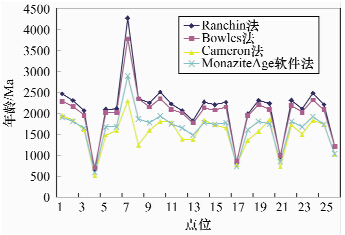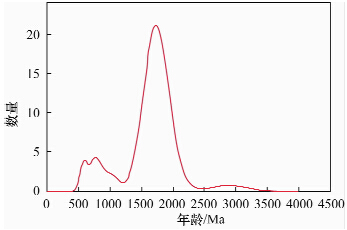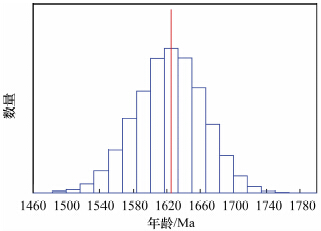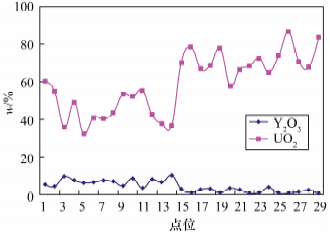| Citation: | huibo Zhao, yafei Liu, shan Yang, meifang Ye, zhihai Wang, bo Wang, na Chang. The Application of Electron Microprobe Dating Method on a Genetic Type of Uraninite[J]. Rock and Mineral Analysis, 2014, 33(1): 102-109. |
The Application of Electron Microprobe Dating Method on a Genetic Type of Uraninite
-
Abstract
Based on the advantages of high resolution and accuracy, Electron Probe Microanalysis (EPMA) method for Th-U-Pb is conducted to date monazite and zircon, is not typically applied in uraninite, pitchblende and other minerals which contain high contents of Th, U and Pb. Uraninite with a high content of U was first found in the iron deposit, whose rock type was chlorite and actinolite biotite altered rock. Based on the region′s geological background, the microscopic alteration, age calculation and other related elements analysis, the uraninite mineralization age and metallogenic regularity have been studied intensely by Microscope and EPMA. The research results indicate that the genetic type of uraninite is similar to the famous metamorphic uraninite in Australia, belonging to the old metamorphic type. The gangue minerals are all chlorite altered by biotite. Occurrence characteristics of the uraninite reveal the close relationship between uraninote and biotite-chlorite. The mineralization age is also intimately related to the formation age of biotite and chlorite. According to the oxide content data of elements (U, Th and Pb) by EPMA, mineralized periods were obtained as the main mineralization stage is (1654±17) Ma-(1805±17) Ma, which is the mid Proterozoic and relate to the hydrothermal alteration of biotite. The later activation and enrichment period is (657±17) Ma-(807±17) Ma, which is the Neoproterozoic Nanhua period when hydrotherm invaded and chloritization was widely developed. Large-sized uraninite grains were selected to calculate their zoning ages. The age distribution shows that the strong fluid activity occurs at the late stage, and is mainly related to the chloritization. In addition, comparing the elements′ content (Y2O3 and UO2) between metamorphic uranium and sedimentary uranium, a negative correlation relationship was found between the two types. This relationship may have significance in determining whether it is metamorphic or sedimentary type, but this conclusion needs further study due to the lack of convincing evidence.-
Keywords:
- uraninite /
- Electron Probe Microanalysis /
- age /
- zone age /
- mineralized periods
-

-
References
[1] 张照志,赵磊,孟庆祝,陈卉泉.电子探针化学测年技术及其在地学中的应用[J].现代地质,2001,15(1): 69-73. [2] 周剑雄,陈振宇,芮宗瑶.独居石的电子探针钍-铀-铅化学测年[J].岩矿测试,2002,21(4): 241-246. [3] 李学军,郭涛,王庆飞.电子探针化学测年方法[J].地学前缘,2003,10(2): 411-413. [4] 张文兰,王汝成,华仁民.副矿物的电子探针化学定年方法原理及应用[J].地质论评,2003,49(5): 253-260. [5] 彭松柏,朱家平,李志昌.电子探针铀-钍-铅定年方法及其在构造分析中的应用前景[J].岩矿测试,2004,23(1): 44-45. [6] 张昭明.电子探针在测定晶质铀矿年龄中的应用[J].放射性地质,1982(5): 408-411. [7] Bowles J F W.Age dating of individual grains of uraninite in rocks from electron microprobe analyses [J]. Chemical Geology,1990,83(1-2): 47-53. [8] Kempe U. Precise electron microprobe age determination in altered uraninite: Consequences on the intrusion age and the metallogenic significance of the Kirchberg granite Erzgebirge, Germany [J].Contributions to Mineralogy and Petrology ,2003,145(1): 107-118. [9] Votyakov S L, Ivanov K S, Khiller V, Bochkarev V,Erokhin Y.Chemical microprobe Th-U-Pb age dating of monazite and uraninite grans from granites of the Yamal crystalline basement [J].Doklady Earth Sciences, 2011, 439(1): 994-997. [10] 葛祥坤.电子探针Th-U-Pb微区测年方法及其在铀矿地质研究中的应用前景[J].铀矿地质,2008,4(3): 175-179. [11] 徐国庆,王爱珍,顾绮芳,张静宜,张昭明,黄裕柱.我国晶质铀矿和沥青铀矿的某些矿物学特征[J].矿物学报,1982(3): 193-199. [12] [13] 孙玉宝.安徽霍邱李老庄铁矿-菱镁矿矿床地质特征及矿床成因类型[J].矿产与地质,2007,21(5): 535-536. [14] Muto T, Hirono S, Kurata H.Some aspects of fixation of uranium from natural waters [J].Mining Geology, 1965,15(74): 287- 298. [15] Nutt C J.Description of drill-hole ⅧV core from the Jabiluka unconformity-type deposit, Northern Territory, Australia [R].U.S. Geological Survey Open-File Report,1984, 2(1): 84-299. [16] Ludwig K R, Grauch R I, Nutt C J, Nash J T, Frishman D, Simmons K R. Age of uranium mineralization at the Jabiluka and Ranger deposits, Northern Territory, Australia: New U-Pb isotope evidence [J].Economic Geology, 1987, 82(4): 857-874. [17] Gustafson L B, Curtis L W. Post-Kombolgie metasomatism at Jabiluka, Northern Territory, Australia, and its significance in the formation of high-grade uranium mineralization in lower proterozoic rocks [J].Economic Geology, 1983, 78(1): 26-56. [18] Ewers G R, Ferguson J.The Nabarlek uranium deposits, Northern Territory, Australia; Some petrologic and geochemical constraints on genesis [J].Economic Geology,1983,78(5): 823-837. [19] Hegge M R, Rowntree J C.Geologic setting and concepts on the origin of uranium deposits in the East Allgator River region, N.T., Australia [J].Economic Geology, 1978, 73(8): 1420-1429. -
Access History

- Figure 1. Mineral features of chlorite and actinolite biotite altered rock
- Figure 2. Comparison of calculated ages with four methods
- Figure 3. The probability statistical chart of uraninite′s mineralization age
- Figure 4. Age distribution of uraninite
- Figure 5. Particle sites of U9 and U18
- Figure 6. Age distribution of U9 and U18
- Figure 7. Comparison of the content of Y2O3 and UO2 in the study area and other sedimentary uranium deposits

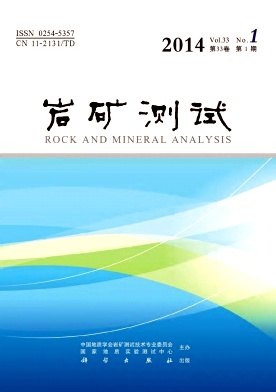



 DownLoad:
DownLoad:
